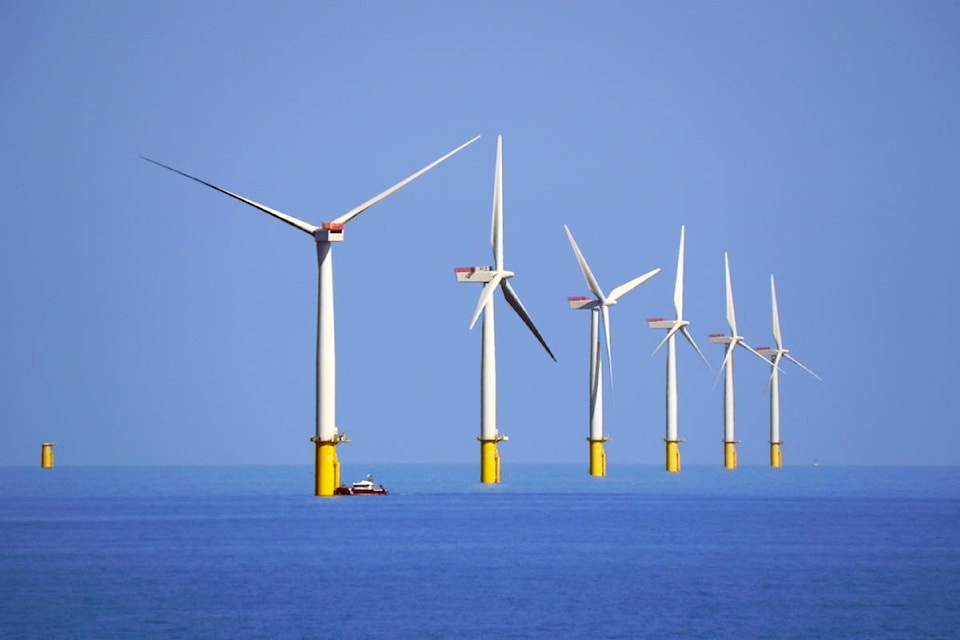Wind energy projects are stirring fresh air into their plans for the North Coast region.
The offshore wind project by NaiKun Wind Energy Group in the Hecate Strait, which began its envrionmental assessment process in 2003, announced a joint development agreement with DONG Energy on Wednesday, Sept. 13.
NaiKun received environmental approvals for a 400-megawatt project from both the provincial and federal governments, but in 2010 after BC Hydro left the project off the list of clean-energy suppliers, the company pressed pause. In 2014, the project received a five-year extension from the B.C. Environmental Assessment Office to delay the start of its project.
The company states it can begin construction within two years of a power purchase agreement.
After years of silence, DONG Energy signed a letter of intent with NaiKun to pursue development of the first offshore wind project in Canada. The Denmark-based company owns and operates 22 offshore wind farms in Europe.
“DONG Energy are by far the largest offshore wind developers in the world,” said Michael O’Connor, president and CEO of NaiKun.
“They’re good at what they do. Siemens, our other partner, is the biggest offshore wind turbine provider in the world.”
One of the reasons he said DONG Energy is interested in working on the project is because the planned location on the Hecate Strait is one of the strongest and most consistent wind resources in the world.
“Offshore wind is a reliable home-grown energy source and we are excited to explore the Canadian market,” said Thomas Brostrøm, president for DONG Energy Wind Power North America, in a press release.
“We see this opportunity as a first step to bringing offshore wind power to Canada in what could become a strategic partnership with the nation’s front-runner project.”
Since NaiKun’s original proposal, the company now plans to use one-third of the turbines to do the same amount of work.
With the project shrinking in scope and impact, NaiKun doesn’t expect it will be required to go through the same environmental assessment process. Originally the project was cited at more than $2 billion but those costs are going to be significantly lowered, O’Connor said.
The partners are currently working on a budget for the first phase. The initial NaiKun Offshore Wind Energy Project designs had wind turbines on towers anchored to the seafloor in a 156 km2 area east of Haida Gwaii in the Hecate Strait. O’Connor said there will still be an underwater cable that connects the wind farm to the BC Hydro grid on Ridley Island, Prince Rupert.
Graham Island will also be supplied via a marine cable that would connect the offshore wind farm to a location near Tlell, taking Haida Gwaii off diesel.
“We’re hoping with a change in government and some of the other conditions that are moving in our favour, greenhouse gas reductions, the need to develop renewable energy, we think we have a really good chance,” O’Connor said.
Mount McDonald and Smith Island
Another wind project on the North Coast is also showing signs of progress. On Aug. 31, the province released an application review for the Mount McDonald Wind Project located on Smith Island and Port Edward. Invenergy has taken over the investigative licence from Bridge Power, and is requesting an area amendment to the project.
“This investigative plan amendment is being submitted as there is more certainty around the layout of the Mount McDonald Wind Project,” wrote James Murphy, vice president of Invenergy, in the letter to the province. The plan lays out a timeline of environmental studies that began in 2015 and will end in 2018.
In 2008, Bridge Power’s Mount McDonald Wind Project identified its site location and did some of the leg work building four 80 metre MET masts for acquiring wind data. Late 2015, Invenergy took over the project that expects to produce 200 megawatts — enough energy for approximately 60,000 homes.
Invenergy has submitted an application to the province to amend its proposal for its wind project in the Port Edward and Smith Island area.
The public is invited to make a comment on project before Sept. 30.
